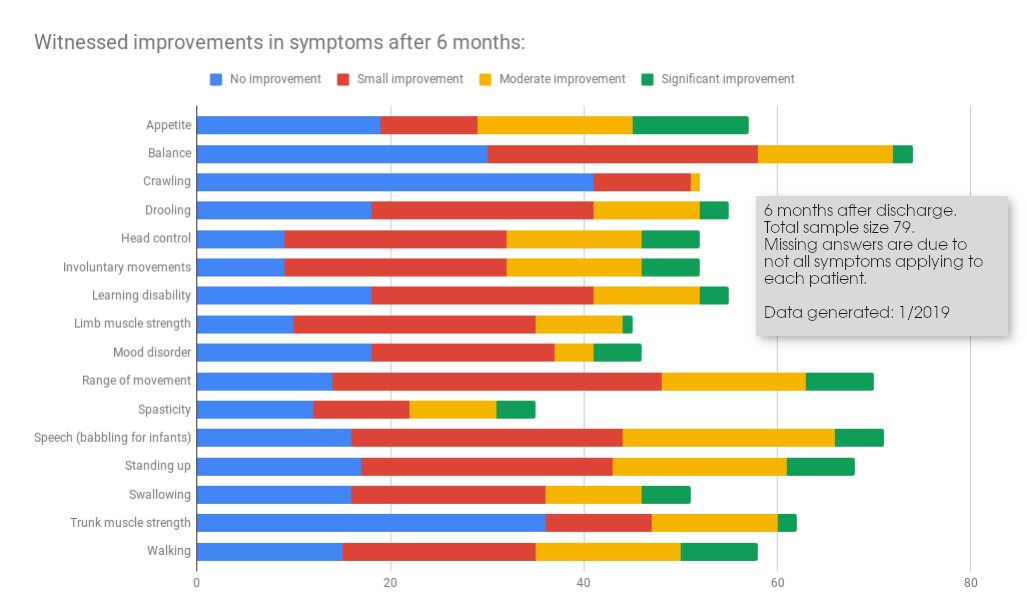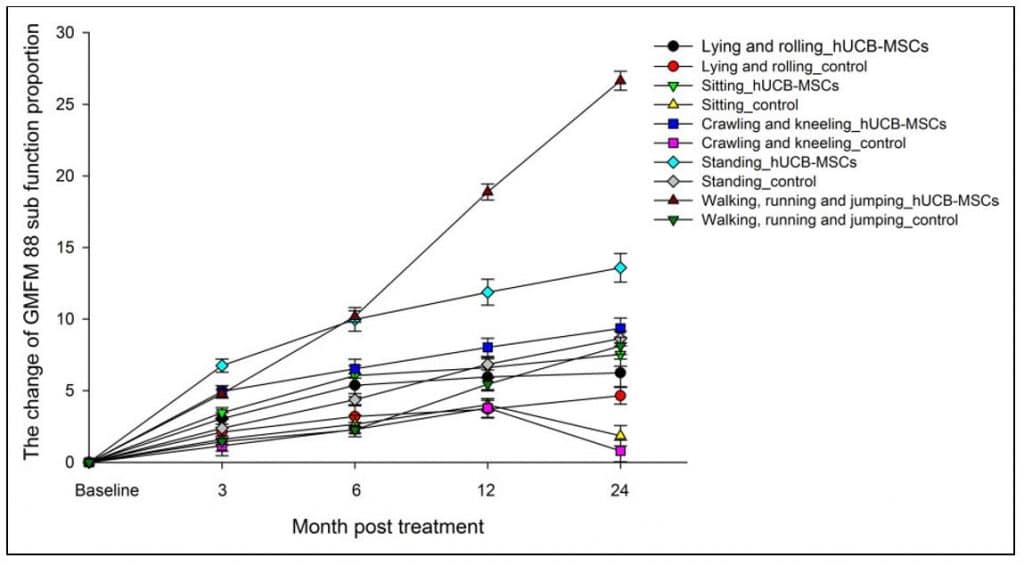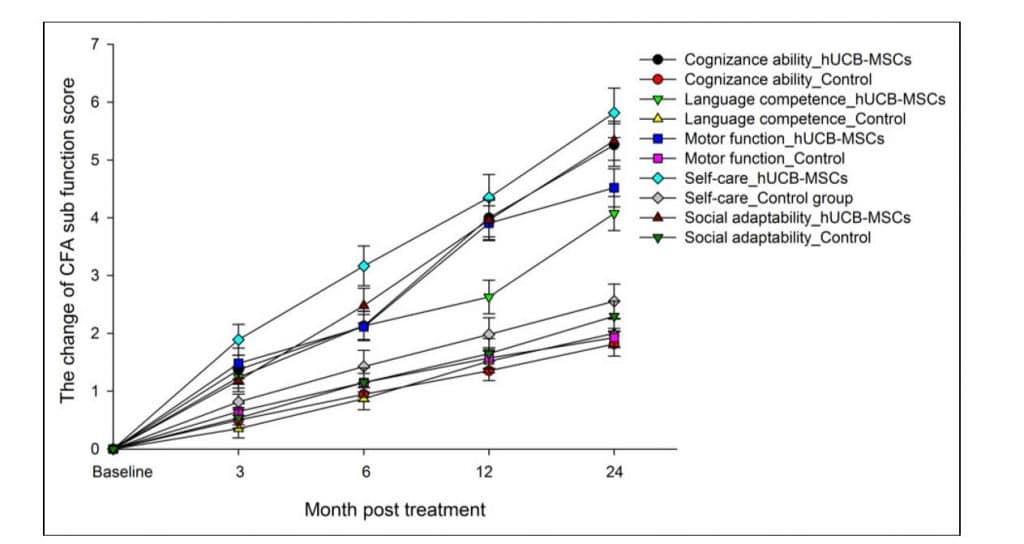What conventional treatment is currently available for cerebral palsy?
There are a number of different areas within the condition that can be helped, and often a cerebral palsy patient will work with different types of doctors to improve on many fronts. Medications exist for patients that have need to relax stiff muscles, and to address some feeding problems in babies. Physical therapy and occupational therapy can help improve a patient’s mobility or ability to perform daily tasks, and speech therapy can be used to improve communication skills. For the most part, therapy and medications are viewed as positive interventions to manage the condition.
However, due to the nature of the condition, improvements in cerebral palsy patients can be difficult with conventional treatment, and damage is often viewed as irreversible as the body regenerative capabilities are insufficient to completely reverse or repair damaged neurons in the brain. Conventional treatments are intended only to mitigate symptoms and make them more manageable, and do not address the root cause, which is considered complete and irreversible.
Can stem cells cure cerebral palsy?
There is currently no cure for cerebral palsy. One of the most promising alternative treatments, however, is stem cell therapy. Stem cells, by addressing the cerebral injury, are able to not only lessen symptoms, but actually reverse some of the original damage and create lasting developments in a child with cerebral palsy. The purpose of stem cell therapy is to restore neurological function in the brain and spinal cord lesion area, and therefore reduce and actually reverse some of those symptoms. However, though these results can be life changing and lasting, this does not count as a “cure” and some milder symptoms will likely remain.
How do stem cells help CP patients?
There are five main points that can be made of the benefits of stem cells for cerebral palsy patients:
1. Reducing the inflammation response, avoiding secondary brain lesion;
2. Differentiating into astrocyte, microglia, oligodendrocyte, neuron and glia cells, which may be good for myelin sheath, axon regeneration, transmission of nerve impulse
3. Producing the cytokines and growth factors, such as glial derived neurotrophic factor (GDNF), brain derived neurotrophic factor (BDNF), nerve growth factor (NGF), neurotrophin 3(NT-3), and neurotrophin 4/5 (NT 4/5) that support brain neuroprotection;
4. Generating new vessel growth, thereby increasing the delivery of oxygen and nutrients to injured and hypoxic tissue;
5. Reducing the intrinsic cell apoptosis (reducing cell death).
What improvements can cerebral palsy patients see from stem cell treatment?
Our patients have experienced improvements that include but are not limited to: Better balance and coordination, reduced fatigue, improved speech, decreased tremors, improved motor function, better swallowing, decreased neuropathic pain, improved mental alertness. It is important to note that, as for any medical treatment, improvement cannot be guaranteed.
What type of stem cells are used for treating cerebral palsy?
Most of our patients diagnosed with cerebral palsy receive umbilical cord blood stem cells (UCBSC) and in some cases, patients will receive umbilical cord mesenchymal stem cells (UCMSC) instead. Both types of stem cells belong to the category of “adult stem cells” and are extracted from umbilical cords gathered from healthy babies after birth.
Umbilical cord blood-derived stem cells contain several sub-categories such as mesenchymal stem cells (MSC), hematopoietic stem cells (HSC), endothelial progenitor cells (EPC), immature immune cells and others. These adult stem cells are able to differentiate into different types of cells, such as osteocytes (bone), chondrocytes (cartilage), myocytes (muscle), fibroblasts (tendon/ligament), adipocytes (fat), hepatic stellate cells (liver), endothelial cells (blood vessels), all blood forming cells (red blood cells, white blood cells, platelets), connective tissues, and more. They are even found to create neurons and glial cells 6. These cells are also able to release products such as cytokines and growth factors that contribute to neural protection 7, and when directed to the brain can stimulate the body’s own repairing of damaged neural cells (neurons).
Is the umbilical cord the only source of adult stem cells?
No. Adult stem cells can be gathered from different sources such as adipose tissues (fat), bone marrow, umbilical cord, and more. It could come from the patient’s own body (autologous) or from a donor (allogenic).
What are the possible side effects of stem cell therapy?
Only few patients have side effects after stem cell injections. Side effects appear right after injection and can include headache, fever, nausea, dizziness, vomiting or pain in the legs. Side effects are temporary and fade away quickly in most cases.
How much does cerebral palsy stem cell treatment cost?
Our comprehensive stem cell treatment starts at $23,000
What are the possible side effects of stem cell therapy?
Only about 5% of our patients suffer from side effects after stem cell injections. Side effects are generally minor and appear right after injection. Side effects can include headache, fever, nausea, dizziness, vomiting, pain in the legs or back pain. Side effects are temporary and fade away quickly in most cases. It is important to note that in most cases side effects are not caused by the stem cells but by the intrathecal injection procedure itself.
From a symptomatic point of view, what are the different types of cerebral palsy?
here are many different cells in the brain that are involved in neurological function, allowing the brain and the rest of the body to communicate properly. There are neurons, astrocytes, microglia, oligodendrocytes, ependymal cells, and many more that are needed to make these connections. The way cerebral palsy exhibits itself can be a result of any or all of these cells being damaged, and can depend on which area of the brain is injured. Cerebral palsy can affect the whole body, including speech, motor and cognitive function, just the legs (paraplegia/paraparesis), or one side of the body (hemiplegia/hemiparesis), but this is not an exhaustive list.
Beyond these areas of the body CP can affect, it also can be categorized in the way it affects those areas. This categorization comes in three main forms:
1. Spastic: this is the most commonly seen form, in which muscle tone is increased, causing muscles to feel stiff and movements to look jerky.
2. Dyskinetic: this form causes involuntary movements that can be twisting, repetitive, slow, or unpredictable. This affects 10-15% of cases and can be very severe.
3. Ataxic: this form is characterized by shaky movements that can cause problems with balance, coordination, spatial positioning, posture, and even the control of eye movements. 5% of cerebral palsy patients have this.
Any mixture of these three forms is possible as well. Diagnosis is generally determined after doctors look at an MRI of the patient’s brain coupled with observed symptoms. The patient is also tracked throughout childhood to monitor the pace of important developmental milestones such as crawling and walking.
How are the stem cells delivered to the patient?
For CP patients, we provide the stem cells intravenous infusions into the bloodstream (IV) and intrathecal injections directed to the spine’s cerebrospinal fluid below the spinal cord conus medullaris. While IV injections are a more systemic mean of delivery allowing regeneration of various areas of the body, the intrathecal injection are targeting the central nervous system in a more direct manner.
Is there an age limit to receive the treatment?
Stem cell treatment for cerebral palsy is more effective in younger children due to their high brain plasticity. Brain plasticity, also called neuroplasticity is the ability for the brain to adapt and form new neural networks around injuries in order to achieve desired results and maximize brain function. Children and young teenagers have the most potential for improvement after stem cell treatment.




